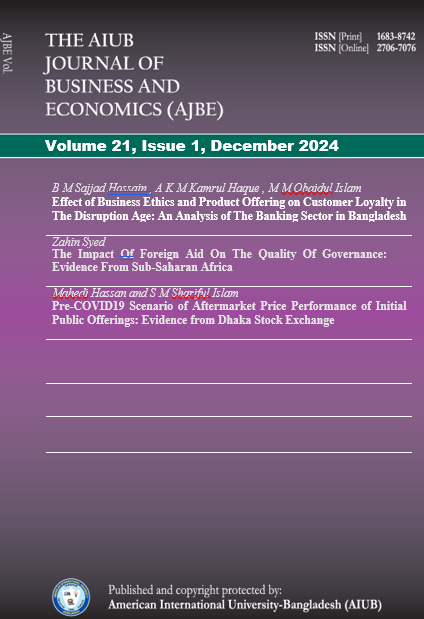Exploring Augmented Reality and Virtual Reality in Education Sector: A Thematic Study Using TOE Framework
Keywords:
Augmented Reality, Virtual Reality, Educational Technology, TOE Framework, Student Engagement, Thematic AnalysisAbstract
Purpose of the study: This study investigates the integration of Augmented Reality (AR) and Virtual Reality (VR) technologies in formal educational settings, with a focus on identifying both the opportunities these tools offer for enhancing student engagement and learning outcomes, and the challenges educators face in their implementation.
Methodology: Adopting a qualitative approach, the research employed thematic analysis using MAXQDA software to code and examine data collected from 38 scholarly articles and semi-structured interviews with four educators from a reputed higher secondary school. The study was guided by the Technology-Organization-Environment (TOE) framework to explore factors influencing AR and VR adoption.
Findings: The analysis revealed that AR and VR technologies significantly enhance motivation, support personalized learning, and improve comprehension of complex subjects. However, widespread adoption is hindered by high costs, inadequate infrastructure, insufficient teacher training, and misalignment with existing curricula. Resistance to pedagogical change also emerged as a barrier to effective integration.
Implications: The findings underscore the need for targeted policy interventions, including professional development initiatives, financial investment, and institutional support mechanisms. By addressing these areas, educational stakeholders can foster more inclusive, immersive, and student-centered learning environments using AR and VR technologies.
Limitations and Future direction: This study is limited by its reliance on English-language literature and a small interview sample from a single institution. Future research should adopt longitudinal designs and explore diverse geographic and socio-economic contexts, particularly in underrepresented and low-resource settings, to better understand the scalability and long-term impact of AR and VR in education.
References
Akçayir, M., & Akçayir, G. (2017). Advantages and challenges associated with augmented reality for education: A systematic review of the literature. Educational Research Review, 20, 1–11.
Alalwan, N., Cheng, L., Al-Samarraie, H., Yousef, R., Ibrahim Alzahrani, A., & Sarsam, S. M. (2020). Challenges and Prospects of Virtual Reality and Augmented Reality Utilization among Primary School Teachers: A Developing Country Perspective. Studies in Educational Evaluation, 66, 1–23. https://doi.org/10.1016/j.stueduc.2020.100876
Babajide Tolulope Familoni, & Nneamaka Chisom Onyebuchi. (2024). Augmented and Virtual Reality in U.S. Education: a Review: Analyzing the Impact, Effectiveness, and Future Prospects of Ar/Vr Tools in Enhancing Learning Experiences. International Journal of Applied Research in Social Sciences, 6(4), 642–663. https://doi.org/10.51594/ijarss.v6i4.1043
Bell, B., & Feiner, S. (2001). Bell VM.pdf. 2001, 101–110.
Bermejo, B., Juiz, C., Cortes, D., Oskam, J., Moilanen, T., Loijas, J., Govender, P., Hussey, J., Schmidt, A. L., Burbach, R., King, D., O’Connor, C., & Dunlea, D. (2023). AR/VR Teaching-Learning Experiences in Higher Education Institutions (HEI): A Systematic Literature Review. Informatics, 10(2), 1–16. https://doi.org/10.3390/informatics10020045
Braun, V., & Clarke, V. (2019). Thematic analysis revised. Journal of Chemical Information and Modeling, 53(9), 1689–1699.
Cheng, K.-H., & Tsai, C.-C. (2020). Students’ motivational beliefs and strategies, perceived immersion and attitudes towards science learning with immersive virtual reality: A partial least squares analysis. British Journal of Educational Technology, 51(6), 2140–2159.
Freina, L., & Ott, M. (2015). a Literature Review on Immersive Virtual Reality in Education: State of the Art and Perspectives. 11th International Conference ELearning and Software for Education, 1, 133–141. https://doi.org/10.12753/2066-026x-15-020
Guttentag, D. A. (2010). Virtual reality: Applications and implications for tourism. Tourism Management, 31(5), 637–651. https://doi.org/10.1016/j.tourman.2009.07.003
Jowallah, R., Bennett, L., Bastedo, K., Jowallah, R. ;, Bennett, L. ;, & Rohan, J. (2018). Leveraging the Affordances of Virtual Reality Systems within K-12 Education: Responding to Future Innovations. FDLA Journal, 3, 7.
Kumaragurubaran, T., Devi, M. V., SenthilPandi, S., & Tharun, M. (2023). Exploring Extended Reality (XR) in the Workplace-Applications, Challenges: Survey. 2023 International Conference on Research Methodologies in Knowledge Management, Artificial Intelligence and Telecommunication Engineering (RMKMATE), 1–5.
McGrath, O., Hoffman, C., & Dark, S. (2023). Future Prospects and Considerations for AR and VR in Higher Education Academic Technology. Owen McGrath, Chris Hoffman, and Shawna Dark,’Future Prospects and Considerations for AR and VR in Higher Education Academic Technology,’EDUCAUSE Review.
Nahid, M. H., Rabbani, G. M. M. N., Mona, L., Anwar, M. A., & Baijed, M. (2024). Exploring factors affecting tertiary students’ stickiness with Edu-Tech GPT. 2024 IEEE Conference on Computing Applications and Systems, COMPAS 2024. https://doi.org/10.1109/COMPAS60761.2024.10796285
Pellas, N., Mystakidis, S., & Kazanidis, I. (2021). Immersive Virtual Reality in K-12 and Higher Education: A systematic review of the last decade scientific literature. Virtual Reality, 25(3), 835–861. https://doi.org/10.1007/s10055-020-00489-9
Ramdani, B., Chevers, D., & Williams, D. A. (2013). SMEs’ adoption of enterprise applications: A technology-organisation-environment model. Journal of Small Business and Enterprise Development, 20(4), 735–753. https://doi.org/10.1108/JSBED-12-2011-0035/FULL/PDF
Rashid, S., Khattak, A., Ashiq, M., Rehman, S. U., & Rasool, M. R. (2021). Educational landscape of virtual reality in higher education: Bibliometric evidences of publishing patterns and emerging trends. Publications, 9(2). https://doi.org/10.3390/publications9020017
Santos, M. E. C., & Sandor, C. (2008). A Usability Scale for Handheld Augmented Reality.
Schwaiger, M., Krajnčan, M., Vukovič, M., Jenko, M., & Doz, D. (2024). Educators’ opinions about VR/AR/XR: An exploratory study. Education and Information Technologies. https://doi.org/10.1007/s10639-024-12808-7
Tene, T., Marcatoma Tixi, J. A., Palacios Robalino, M. de L., Mendoza Salazar, M. J., Vacacela Gomez, C., & Bellucci, S. (2024). Integrating immersive technologies with STEM education: a systematic review. Frontiers in Education, 9. https://doi.org/10.3389/feduc.2024.1410163
Vogt, F. P. A., & Shingles, L. J. (2013). Augmented Reality in astrophysics. Astrophysics and Space Science, 347(1), 47–60. https://doi.org/10.1007/s10509-013-1499-x
Wu, H. K., Lee, S. W. Y., Chang, H. Y., & Liang, J. C. (2013). Current status, opportunities and challenges of augmented reality in education. Computers and Education, 62, 41–49. https://doi.org/10.1016/j.compedu.2012.10.024
Zhang, W. (2021). Theory and Practice of VR_AR in K-12 Science Education—A Systematic Review _ Enhanced Reader.pdf.
Zhu, K., Kraemer, K. L., & Xu, S. (2006). The process of innovation assimilation by firms in different countries: A technology diffusion perspective on e-business. Management Science, 52(10), 1557–1576. https://doi.org/10.1287/MNSC.1050.0487
Downloads
Published
How to Cite
Issue
Section
License
Copyright (c) 2025 AIUB Journal of Business and Economics

This work is licensed under a Creative Commons Attribution-NonCommercial 4.0 International License.

